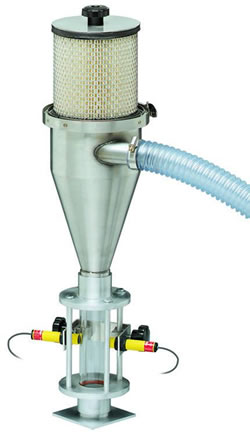Compressed Air Loaders

These stand-alone self-contained loaders require no timers, nor vacuum sealing for operation. Material is drawn from the source container and then pushed to the receiver by an efficient, aluminum compressed air venturi.
The rate of material flow is controlled by adjusting the flow of plant compressed air through the venture.
An adjustable -height photo-eye sensor signals the compressed air regulator when to begin the loading cycle and shuts off the air to stop conveying when material reaches the sensor
It is possible to transfer up to 500 lb./hr. of plastic pellets and regrind over a distance of about 15 feet. The compressed air loader may be mounted on bins, hoppers or machine throats.
Features to look for:
- A selection of base plates should be available for mounting to any bins, hoppers or directly to a machine throat
Possible options:
- A dual inlet proportioning kit should be available to allow simultaneous proportional loading (by air pressure) of regrind with virgin material
- A dust bag filter kit is a handy option when conveying dusty regrind as it extends the life of the cartridge filter
Drawbacks:
Operating a large number of compressed air loaders is costly from an energy standpoint because of the compressed air usage. Also, since they only convey material about 15 feet, the material source (usually a Gaylord) has to be kept nearby, on the production floor, which adds clutter, requires access by fork lifts or pallet jacks.



